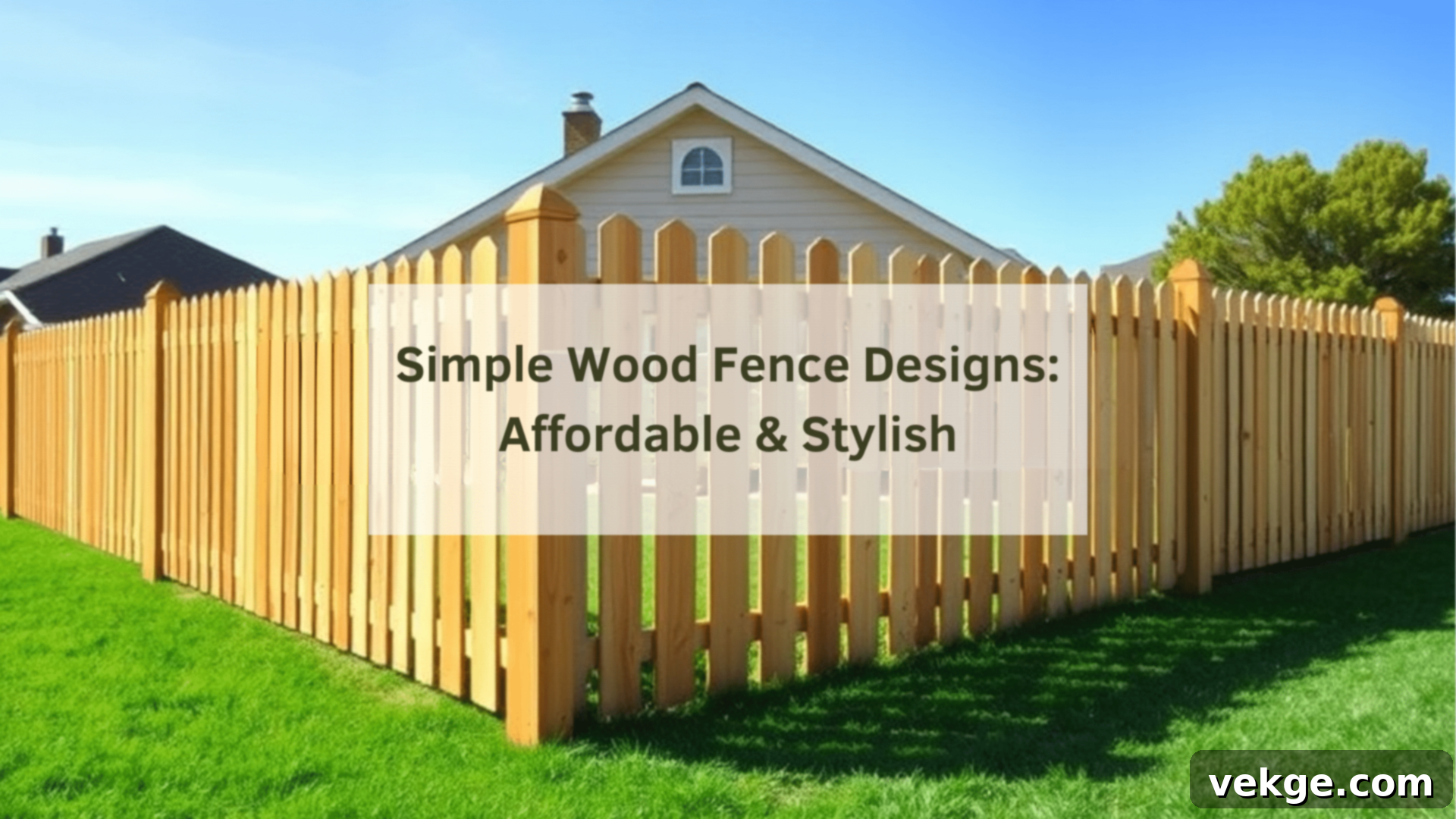The Ultimate Guide to Wood Fences: Designs, Benefits, and Maintenance for Your Home
For homeowners seeking a perfect blend of natural beauty, privacy, and long-lasting value, wood fences stand out as an exceptional choice. Beyond their timeless aesthetic appeal, wood fences offer a unique combination of affordability, versatility, and environmental friendliness that few other fencing materials can match. Whether you’re looking to define your property lines, enhance curb appeal, or create a private backyard oasis, a well-chosen wooden fence can transform your outdoor living space.
One of the primary advantages of opting for a wood fence is its remarkable cost-effectiveness compared to many other popular fencing options like vinyl, wrought iron, or composite materials. Despite their budget-friendly nature, wood fences do not compromise on visual appeal or durability. When properly installed and maintained, a high-quality wooden fence can serve your property for decades, providing both security and a significant boost to your home’s exterior aesthetics.
The versatility of wood fences is another compelling benefit. They are remarkably adaptable, allowing for a vast array of customization options to perfectly suit your personal style and property requirements. From towering privacy barriers to charming decorative borders, wood can be shaped, stained, or painted to achieve virtually any look. This flexibility extends to construction and repair; wood fences are generally straightforward to install for DIY enthusiasts and relatively easy to repair should a section become damaged, often requiring just a few replacement boards rather than an entire panel.
Moreover, wood fences are excellent performers in diverse climates, naturally complementing the environment with their warm, organic textures. They integrate seamlessly into any landscape design, adding a touch of rustic charm or modern elegance depending on the chosen style. Investing in a quality wood fence not only elevates the visual appeal of your home but also provides essential privacy and enhanced security, making it a valuable addition to any property.
Best Simple Wood Fence Designs
1. Picket Fences
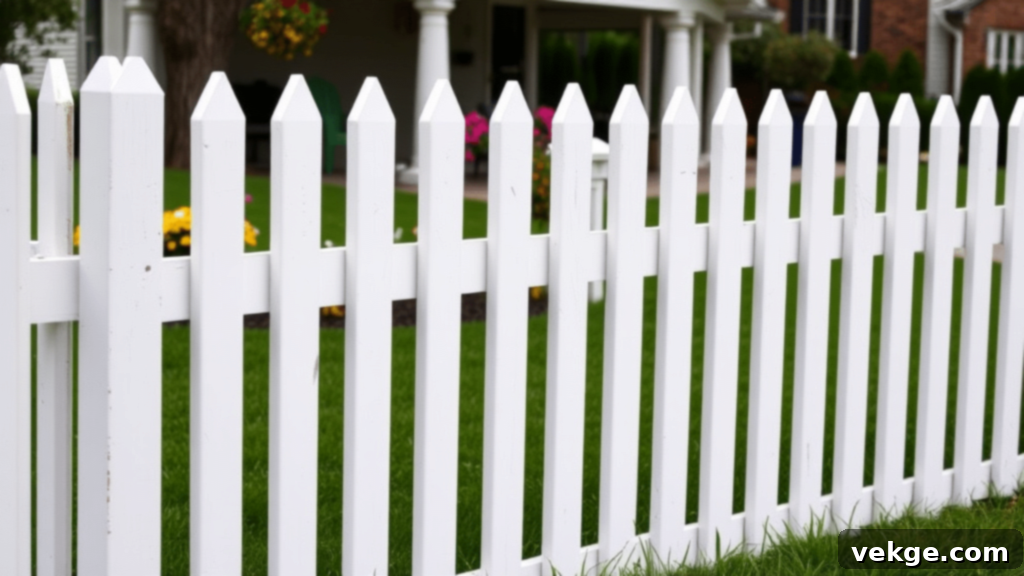
Picket fences are perhaps the most iconic and beloved symbol of suburban charm, instantly adding a classic American aesthetic to any home. They are an incredibly cost-effective option, making them accessible for homeowners looking to enhance their property without a significant financial outlay. Characterized by evenly spaced vertical boards, often featuring decorative pointed or rounded tops, picket fences offer a visually appealing boundary that feels open and welcoming.
While they don’t provide full privacy, picket fences are perfect for defining property lines, accentuating garden beds, or creating a picturesque front yard. Their design allows for a friendly connection with the neighborhood, enabling casual conversations while clearly marking your personal space. Available in various heights and styles, from short, purely decorative borders to slightly taller options that deter pets, picket fences can be customized to match your home’s architectural style and your personal taste. They can be painted crisp white for a traditional look or stained in natural wood tones for a more rustic feel.
2. Board-on-Board Fences
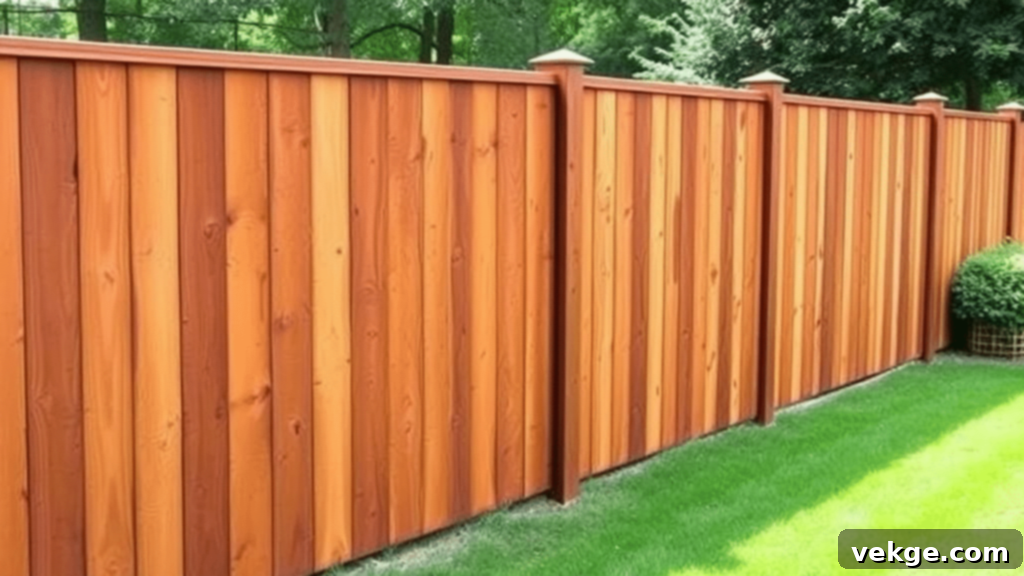
When privacy is a top priority, board-on-board fences are an excellent and elegant solution. This sophisticated fence design features overlapping vertical boards installed on both sides of the fence rails. The genius of this construction lies in how each board on one side is strategically positioned to cover the gaps between the boards on the opposite side. This staggered arrangement ensures a virtually impenetrable visual barrier, making it extremely difficult for anyone to peek through, even as the wood naturally expands and contracts with changes in weather.
Despite offering superior privacy, the board-on-board design also cleverly allows for some air circulation. This not only helps with the fence’s structural integrity by reducing wind resistance but also creates a more pleasant atmosphere within your private outdoor space. These fences typically offer a uniform, attractive appearance from both sides, making them a neighbor-friendly option. Ideal for backyards, pool enclosures, or any area where seclusion is desired, board-on-board fences combine robust security with a refined aesthetic, adding substantial value and tranquility to your property.
3. Post-and-Rail Fences

For those aiming to evoke a rustic, open-country charm, post-and-rail fences are the quintessential choice. This classic design is characterized by sturdy vertical posts joined by horizontal rails, creating a simple yet effective boundary. Unlike privacy fences, post-and-rail fences are designed to clearly delineate property lines without obstructing scenic views, making them ideal for larger plots of land, ranches, or homes nestled in picturesque rural settings.
Post-and-rail fences are not only aesthetically pleasing but also highly practical for certain applications. They are commonly used for enclosing pastures, containing livestock (often with the addition of wire mesh), or simply establishing a natural-looking border around expansive yards. Their open design allows sunlight to pass through freely, benefiting landscaping, and their robust construction ensures long-term durability with minimal maintenance. Easy to install and repair, these fences offer a timeless, pastoral appeal that beautifully complements natural landscapes and country-style architecture.
4. Horizontal Slat Fences
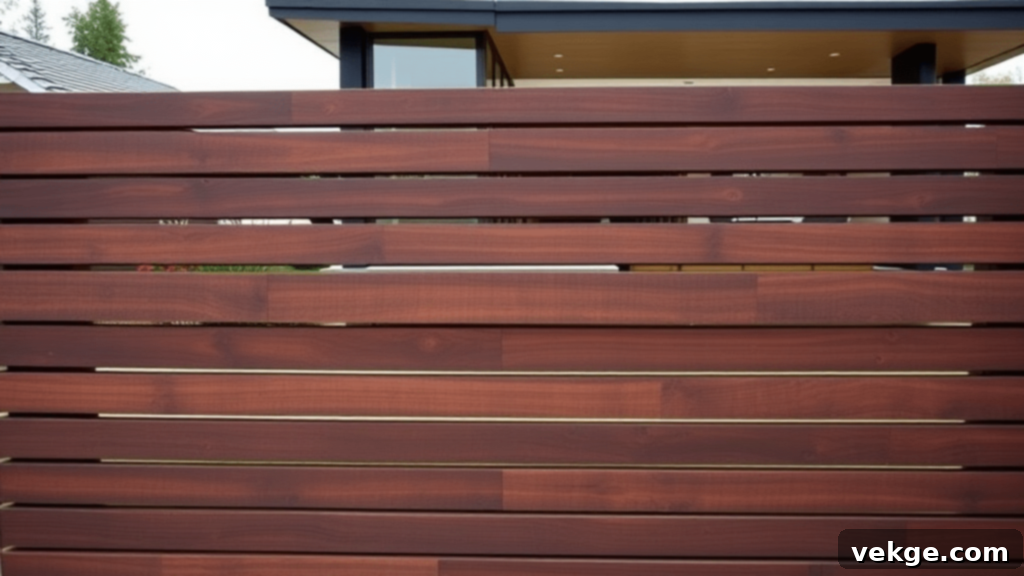
Horizontal slat fences offer a distinctive, contemporary aesthetic that instantly modernizes any property. Breaking away from traditional vertical installations, these fences feature boards running horizontally, creating sleek, clean lines that can significantly enhance the visual appeal of modern and minimalist architectural styles. The linear orientation creates an illusion of width, which can make smaller yards appear more expansive and open.
This design offers flexibility in terms of privacy; slats can be placed close together for maximum seclusion or spaced slightly apart to allow for partial views and airflow, mimicking a louvered effect. Horizontal fences are particularly popular in urban settings and with homeowners who appreciate clean, geometric patterns. They provide a sophisticated backdrop for landscaping and outdoor living areas, and when crafted from premium woods like cedar or redwood, they exude a sense of refined elegance that elevates the overall design of your home and garden.
5. Lattice Fences
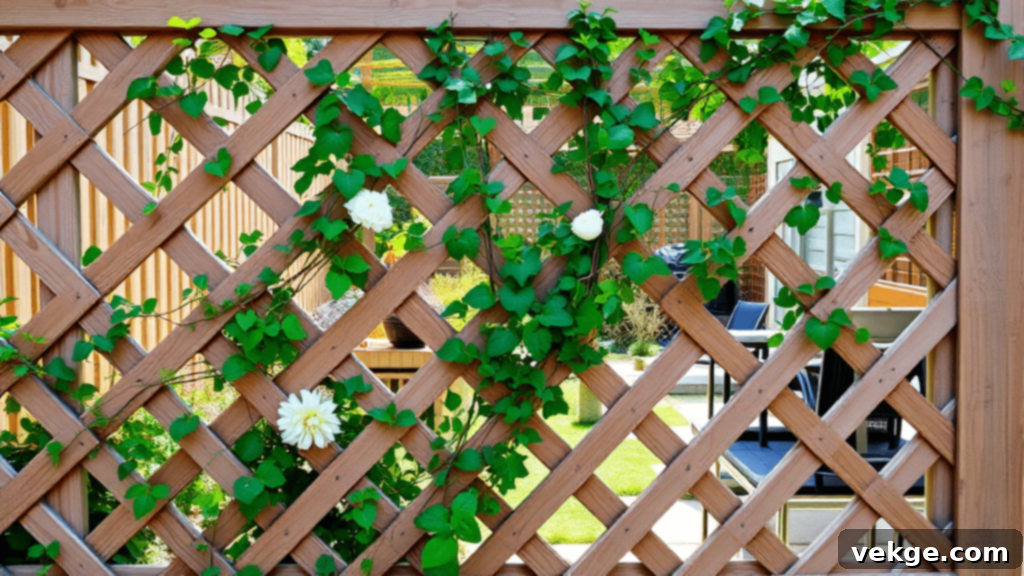
Lattice fences offer a beautiful balance between decorative charm and practical functionality, providing a delicate yet effective boundary. Characterized by their signature criss-cross pattern of thin wood strips, lattice designs allow generous amounts of light and air to pass through, preventing your outdoor space from feeling enclosed or stifled. This open weave simultaneously offers a degree of privacy, creating a soft visual screen without completely blocking views.
Beyond their standalone appeal, lattice panels are frequently incorporated as decorative toppers on solid privacy fences, adding an elegant finish and extra height without the heavy feel of continuous solid wood. They are also incredibly popular as trellises, providing excellent support for climbing plants, vines, and roses, which can further enhance privacy and add vibrant greenery to your fence line. Whether used as a standalone feature for dividing garden rooms, a decorative accent, or a living wall support, lattice fences introduce a sophisticated texture and architectural interest to any landscape.
6. Split Rail Fences
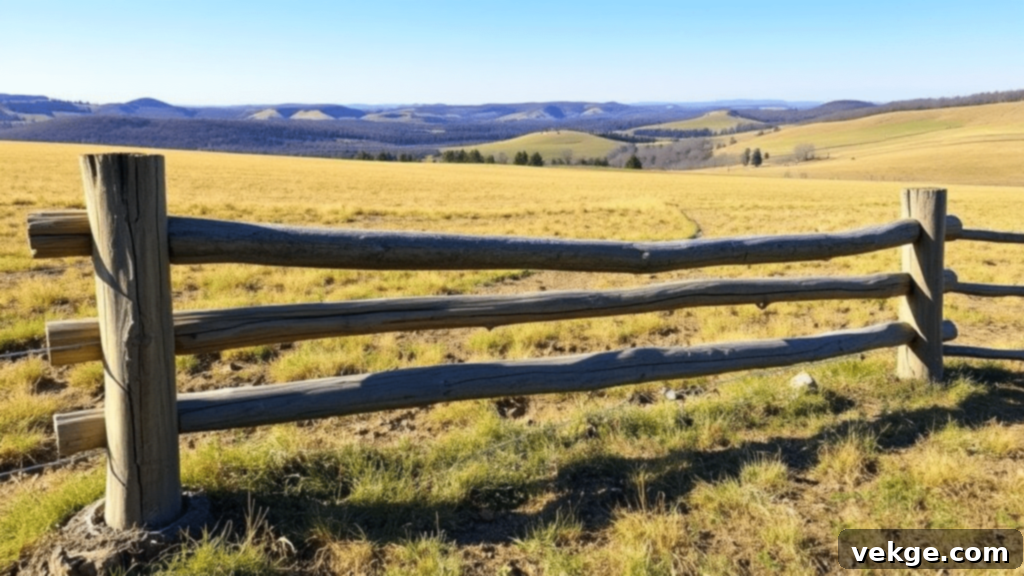
Similar in spirit to post-and-rail but with a distinctly rugged character, split rail fences are an excellent choice for expansive properties, farms, and rural homesteads where a natural, understated boundary is desired. These fences are traditionally constructed from rough-hewn logs, typically cedar, oak, or pine, which are split lengthwise to create irregular, rustic rails. This method of construction gives each fence a unique, organic appearance that perfectly blends with natural surroundings.
Split rail fences are highly appreciated for their ease of installation and long-term durability, especially when using naturally rot-resistant woods. Their open design is not intended for privacy or security in the same way solid fences are, but they excel at defining large perimeters, containing pets within a large yard (often combined with mesh), or simply enhancing a natural, country-style landscape. They represent one of the most cost-effective and enduring options for marking boundaries on significant land areas, offering timeless appeal and minimal upkeep.
Choosing the Right Wood for Your Fence
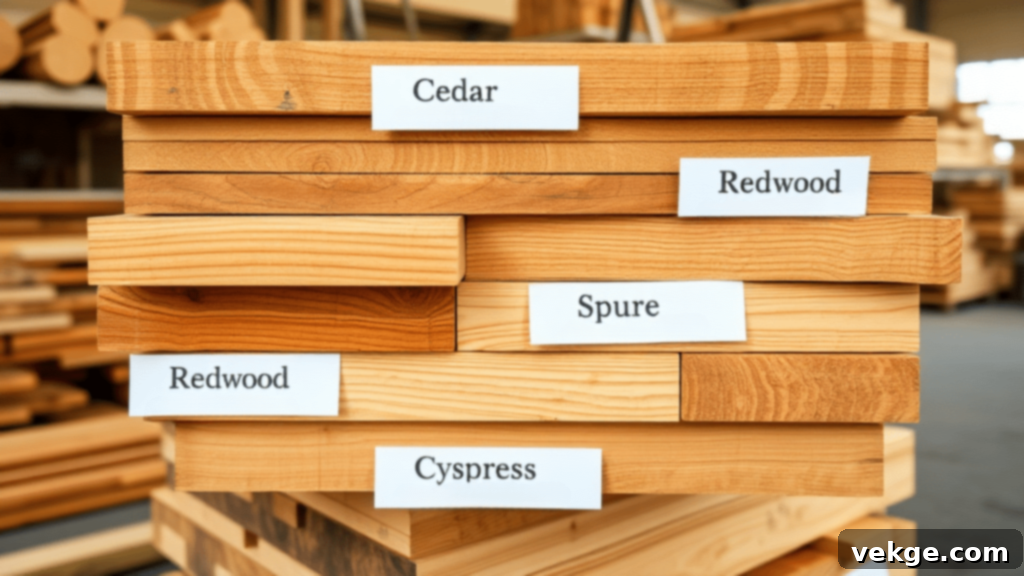
Most Affordable Options: Pine, Spruce, Fir
When budget is a primary consideration, but you still desire the natural beauty and structural integrity of a wooden fence, species like pine, spruce, and fir offer excellent value. These readily available softwoods are typically less expensive than hardwoods or naturally resistant species, making them a popular choice for homeowners seeking a cost-effective fencing solution. While they may require more diligent maintenance, they can still provide years of reliable service and an attractive appearance.
Pine is widely favored for its versatility and ease of workability. Its softer nature makes it simple to cut, nail, and shape, which is a significant advantage for DIY installations. Pine accepts stains and paints beautifully, allowing for extensive customization to match your home’s aesthetic. To maximize its lifespan, pine fences often require pressure treatment to resist rot and insect infestation, and regular sealing or staining is essential.
Spruce is another economical option, particularly common in colder climates where it grows abundantly. It boasts good strength-to-weight ratio and has a natural resistance to warping, making it a stable choice for fence boards. Like pine, spruce benefits greatly from proper treatment and sealing to protect against moisture and pests, ensuring it stands up well to the elements.
Fir, known for its straight grain and uniform texture, provides excellent stability and strength, making it suitable for both fence posts and panels. Its clear, straight grain also lends itself to a clean, modern look when stained. While fir is generally more durable than pine or spruce, it still requires protective finishes to enhance its longevity and ward off potential environmental damage.
Best for Longevity: Cedar, Redwood, Cypress
For homeowners prioritizing durability, minimal long-term maintenance, and superior resistance to environmental challenges, certain premium wood species are unparalleled. These woods naturally contain oils and compounds that offer inherent protection against common fence adversaries like insects, rot, and decay, ensuring your investment stands strong for decades.
Cedar is consistently ranked as one of the best wood types for fencing due to its exceptional natural properties. It contains powerful natural oils that act as fungicides and insecticides, making it highly resistant to rot, decay, and insect damage. This inherent protection means that cedar fences can last an impressive 15 to 30 years or even longer with basic maintenance like cleaning and occasional sealing. Cedar also boasts a beautiful, aromatic scent and a charming reddish-brown hue that gracefully weathers to a silver-grey patina if left unstained.
Redwood is another magnificent choice, prized for its stunning rich, reddish-brown color and extraordinary longevity. Like cedar, redwood possesses natural tannins and oils that provide excellent resistance to insects and decay. It is also remarkably stable, meaning it’s less prone to warping, shrinking, or cracking, even in diverse climates. Redwood fences can easily last 20-30 years, often becoming more beautiful with age. Its premium price reflects its superior durability and aesthetic appeal.
Cypress, often found growing in wetlands, has developed an incredible natural ability to resist moisture, making it an outstanding choice for fences in humid or damp environments. Its inherent resistance to rot and insect infestation is comparable to cedar and redwood, offering impressive longevity. Cypress wood has a distinctive grain and a light, appealing color that can be easily stained or left to weather naturally, providing a durable and attractive fencing solution that can withstand challenging conditions for many years.
Treated vs. Untreated Wood: Pros and Cons
Understanding the difference between treated and untreated wood is crucial when selecting materials for your fence, as it impacts cost, durability, and maintenance requirements. Each option presents distinct advantages and considerations.
Treated Wood: Pressure-treated wood undergoes a process where chemical preservatives are forced deep into the wood fibers. These chemicals are designed to protect the wood from rot, decay, and insect infestations, significantly extending its lifespan, especially when used in ground contact or high-moisture areas. While the initial cost of treated wood is typically higher than untreated, its enhanced durability often translates to lower maintenance costs and a longer service life, making it a cost-effective choice in the long run. Modern pressure treatments are generally safe for residential use, including areas accessible to children and pets, as the chemicals are bonded within the wood.
Untreated Wood: This refers to wood that has not undergone any chemical preservation process. Its primary appeal lies in its lower upfront cost and its completely natural aesthetic. Untreated wood, particularly species like pine, spruce, or fir, will require more consistent maintenance in the form of regular sealing or staining every few years to protect it from moisture, UV damage, and pests. However, naturally resistant woods like cedar, redwood, and cypress can be used untreated due to their inherent oils and compounds, which provide natural defense against decay and insects. Choosing untreated wood, especially these naturally durable species, is often preferred by those who desire the most authentic, organic look and feel for their outdoor spaces.
The decision between treated and untreated wood ultimately depends on your budget, desired aesthetic, and willingness to perform ongoing maintenance. For maximum longevity and minimal fuss, treated wood is often the practical choice, especially for the structural components of your fence. If you value a purer, natural appearance and are prepared for more frequent protective applications, untreated wood, especially a naturally resistant species, can offer stunning results.
Privacy & Security Considerations for Wood Fence
A primary motivation for many homeowners in installing a wood fence is to enhance the privacy and security of their property. A well-designed wooden fence can create a secluded sanctuary in your backyard, shield your home from prying eyes, and act as a significant deterrent to unwanted intruders. Here are detailed strategies to maximize both aspects:
Maximizing Privacy with Your Wood Fence
Achieving optimal privacy primarily involves minimizing visibility through or over your fence. Consider these effective methods:
- Solid Construction: The most straightforward approach is to choose fence styles where boards are placed tightly together, ideally overlapping slightly (like board-on-board or solid panel fences), to eliminate any gaps. This creates an uninterrupted visual barrier.
- Strategic Landscaping: Integrate climbing plants, dense shrubs, or tall hedges along your fence line. Vines like ivy, wisteria, or climbing roses can be trained to grow directly onto lattice sections or woven through gaps, adding a lush, green layer of privacy. Strategic planting not only adds beauty but also provides an organic, living screen.
- Auxiliary Screens: For existing fences with gaps, or for areas needing temporary or enhanced privacy, consider adding supplementary screens. Outdoor privacy curtains, bamboo roll-up screens, or decorative metal panels can be attached to sections of your fence to block views effectively.
- Fence Height: Opt for the maximum permissible fence height in your local municipality. While standard heights are often 6 feet, some areas allow up to 8 feet, offering a significantly greater degree of seclusion. Always check local zoning laws before planning.
Adding Lattice Tops or Taller Panels for Enhanced Privacy
Beyond a solid fence, there are creative ways to increase height and visual obstruction without making the entire structure appear too imposing. Adding decorative elements to the top of your fence can be both functional and aesthetically pleasing.
Lattice Tops: These elegant additions are a popular choice for extending fence height while maintaining an open, airy feel. Lattice panels, with their characteristic criss-cross pattern, sit atop your main fence structure. They effectively deter casual glances over the fence line, offering enhanced privacy without creating a solid, ‘heavy’ wall. Furthermore, lattice is an excellent support structure for climbing plants and vines, which can grow to fill the openings, providing an organic and beautiful privacy screen that changes with the seasons.
Taller Solid Panels: If the decorative look of lattice isn’t quite your style, or if you require a more robust height extension, simple taller solid panels can be attached to the top of your existing fence. These extensions can seamlessly blend with the fence below or offer a contrasting design element. It’s crucial to consult local building codes and homeowner association (HOA) rules regarding maximum fence heights, as most municipalities have regulations, typically allowing fences up to 6 or 8 feet. Utilizing this permissible height provides a significant boost to your property’s seclusion.
Best Wood Fence Styles for Enhanced Security
While all fences offer some level of boundary definition, certain wood fence styles are inherently better suited for deterring intruders and enhancing property security. Selecting the right design, combined with smart practices, can significantly bolster your home’s defenses.
- Stockade Fences: This classic style is a top contender for security. Stockade fences are characterized by tall, closely packed vertical boards, often with pointed or dog-eared tops, installed edge-to-edge without gaps. This solid construction makes them incredibly difficult to climb or see through, presenting a formidable barrier. The height and lack of footholds are key deterrents.
- Solid Board Fences: Similar to stockade but often with flat tops, a solid board fence constructed with no gaps between the planks offers a robust and impenetrable barrier. The continuous surface not only blocks vision but also prevents easy handholds or toeholds, making unauthorized entry exceptionally challenging. For optimal security, aim for a fence that is at least 6 feet tall, preventing most people from simply stepping over.
- The Importance of Gates and Locks: A fence is only as secure as its weakest point. Investing in a robust, well-constructed gate that matches the height and solidity of your fence is paramount. Equip it with high-quality, tamper-resistant locks or latches. Consider adding self-closing hinges and a deadbolt for maximum protection.
- Perimeter Enhancements: For an extra layer of security, consider placing deterrents around the fence line. A strip of small, loose gravel or thorny bushes (like barberry or pyracantha) planted along the base of the fence can make approaching the fence audibly noticeable or physically uncomfortable, providing an early warning system against potential intruders.
Easy Maintenance Tips for Wood Fence
Sealing and Staining Recommendations for Longevity
Proper maintenance is the cornerstone of a long-lasting and attractive wood fence. Regular sealing or staining not only enhances its aesthetic appeal but also provides vital protection against the elements, preventing premature aging, rot, and decay. Aim to reapply a protective finish every 2-3 years, depending on your climate and the product used.
Preparation is Key: Before applying any sealer or stain, thorough preparation is essential. Begin by cleaning your fence completely. Use a pressure washer on a low setting or a stiff brush with a mild wood cleaner to remove dirt, mildew, algae, and loose debris. Allow the fence to dry thoroughly, typically for 24-48 hours, ensuring no moisture is trapped within the wood, which could compromise the finish.
Choosing the Right Day: Select a dry, mild day with no rain in the forecast for at least 24 hours after application. Avoid extremely hot or cold temperatures, as these can affect the product’s adhesion and drying time. Overcast days are often ideal as direct sunlight can cause stains and sealers to dry too quickly, leading to uneven application.
Application Technique: Apply your chosen sealer or stain evenly, working from the top of the fence downwards to avoid drips and streaks. A brush is excellent for detailed work and ensures good penetration, while rollers or sprayers can cover larger areas more quickly. If using a sprayer, always back-brush immediately after spraying to work the product into the wood grain. Always follow the manufacturer’s instructions for the specific product you are using regarding coats, drying times, and reapplication intervals. Regular sealing will not only preserve the wood but also maintain its vibrant color and natural beauty for years to come.
Preventing Rot and Insect Damage: Proactive Steps
Beyond sealing and staining, several proactive measures can significantly extend the life of your wood fence by mitigating the risks of rot and insect infestation, which are common enemies of timber structures.
- Maintain Clear Perimeters: Ensure that plants, bushes, and garden beds are kept at a safe distance from your fence. Direct contact with vegetation can trap moisture against the wood, promoting mildew growth and rot. Similarly, keep soil and mulch at least 2-4 inches away from the bottom of the fence posts and panels to prevent moisture wicking and direct ground contact, which is a major source of decay. Ideally, the bottom of your fence panels should sit at least 2 inches above the ground level.
- Ensure Proper Drainage: Water accumulation is a prime culprit for wood rot. Inspect your property to identify any areas where water tends to collect near the fence line after rain. Implement solutions such as grading the soil away from the fence, installing French drains, or creating small drainage holes at the bottom of solid fence panels to allow trapped water to escape. Proper drainage ensures that water does not sit against the wood for extended periods.
- Utilize Wood Treatments: For untreated woods or even as an extra layer of defense for treated lumber, consider applying specific wood treatments designed to deter insects and inhibit fungal growth. Borate-based treatments are eco-friendly options that penetrate the wood to prevent decay and insect damage. For posts that are in ground contact, a post-saver sleeve or a robust wood preservative specifically designed for ground contact can provide critical protection.
- Regular Inspections: Make it a habit to inspect your fence thoroughly at least twice a year, ideally in spring and fall. Look for any signs of damage, such as cracking, splitting, discoloration, soft spots (indicating rot), or small holes (suggesting insect activity). Early detection allows for timely intervention before minor issues escalate into costly repairs. Pay close attention to the bottom of posts and panels, as these areas are most vulnerable to moisture and ground contact.
Quick Repairs for Common Wood Fence Issues
Addressing minor fence problems as soon as they arise is critical for preventing larger, more expensive issues down the line. Many common fence repairs can be tackled quickly and efficiently by a homeowner with basic tools.
- Loose Boards: One of the most frequent issues is loose or detached fence boards. Reattach them using rust-resistant screws or galvanized nails that are long enough to penetrate firmly into the rails. Screws generally offer a stronger hold than nails and are less likely to pull out over time. If the wood around the old fastener is deteriorated, reposition the board slightly and use a new fastening point.
- Cracks and Small Holes: Minor cracks or small holes, perhaps from old nails or impacts, can be filled with an exterior-grade wood filler. Once dry, sand the area smooth and apply a matching stain or paint to protect the patched section and blend it with the rest of the fence. This prevents water from seeping in and causing further damage.
- Leaning Posts or Sections: A leaning fence section often indicates a compromised fence post. For wooden posts set directly in the ground, the wood at or below ground level may have rotted. If the post is still sound above ground, you might be able to re-stabilize it by digging out the old concrete and soil, adding fresh gravel for drainage, setting the post plumb, and pouring new concrete. For severely rotted posts, replacement is the best option.
- Damaged Boards: Boards that are extensively cracked, split, or rotted should be replaced promptly. Keeping a few spare boards of the same wood type and dimensions as your fence can make these replacements seamless. If you don’t have spares, measure carefully and purchase new lumber, ensuring it’s treated or sealed to match the rest of your fence. Prompt replacement not only restores the fence’s integrity but also maintains its aesthetic appeal.
- Gates That Sag: Sagging gates are common and frustrating. Often, this can be fixed by tightening hinges or adding a diagonal brace from the bottom hinge side to the top latch side, providing structural support against gravity. Adjustable gate kits are also available to correct severe sagging.
By staying vigilant and addressing these common issues proactively, you can significantly extend the lifespan of your wood fence, preserving its beauty and functionality for many years.
Conclusion
The journey to selecting the perfect wood fence for your property involves a thoughtful consideration of various factors, each playing a crucial role in the ultimate outcome. From the initial investment to the long-term enjoyment and maintenance, every decision contributes to creating an outdoor space that is both functional and aesthetically pleasing. Ultimately, the “right” wood fence is one that perfectly balances your budget, desired aesthetic, durability expectations, and willingness to commit to ongoing maintenance.
As we’ve explored, the array of wood fence designs — from the charming picket to the robust board-on-board, or the rustic post-and-rail — offers something for every taste and need. Similarly, understanding the characteristics of different wood types, whether you prioritize affordability with pine or superior longevity with cedar and redwood, is key to making an informed decision. Remember to factor in your local climate conditions, as some woods and treatments are better suited to specific environmental challenges, and always verify local building codes for height and material restrictions.
Investing in a high-quality wood fence is more than just marking a boundary; it’s an enhancement to your home’s curb appeal, a boost to your family’s privacy and security, and a significant addition to your property’s overall value. With proper planning, diligent installation (whether DIY or professional), and consistent, easy maintenance, your wood fence will stand as a beautiful, functional, and enduring testament to your personal style for many years to come.
We hope this comprehensive guide has provided you with the insights needed to embark on your wood fencing project with confidence. We’d love to hear about your experiences and see your completed fences! Please feel free to share your photos, tips, and personal stories in the comments section below. Your contributions can inspire and assist other homeowners in their own quest for the perfect wooden perimeter.
Frequently Asked Questions
What’s the Most Cost-Effective Way to Build a Wood Fence?
The most budget-friendly way to construct a wood fence typically involves using readily available and less expensive wood species, combined with a simple design. Pine, spruce, and fir are the most affordable wood options for fencing. For designs, a simple post-and-rail fence or a basic picket fence with minimal decorative elements will keep material costs down. Opting for a DIY installation, if you have the skills and time, can also significantly reduce labor costs. While wire fences (like chain link or woven wire) are generally cheaper overall, for a true wood fence, prioritizing basic designs and economical lumber types offers the best value.
How Long Can a Wood Fence Be Expected to Last?
The lifespan of a wood fence varies considerably, generally ranging from 10 to 30 years, though some exceptional cases can exceed this. Several critical factors influence its durability. The type of wood chosen is paramount: naturally rot-resistant woods like cedar, redwood, and cypress can easily last 20-30 years with proper care due to their inherent protective oils. More economical woods like pine, spruce, and fir typically last 10-15 years, especially if pressure-treated and consistently maintained. Local climate, including exposure to humidity, rain, sunlight, and pests, also plays a significant role. Crucially, the quality of installation and the consistency of maintenance – such as regular cleaning, sealing or staining, and prompt repairs – are vital for maximizing your fence’s longevity.
Should I Paint or Stain My Wood Fence, and What’s the Difference?
The choice between painting and staining your wood fence depends on your desired aesthetic, the wood type, and your willingness for future maintenance. Stain penetrates the wood fibers, allowing the natural grain and texture of the wood to show through, enhancing its inherent beauty. It provides UV protection and water resistance, and when it’s time for reapplication, often simply needs a fresh coat over a clean surface, as it wears down gradually. Paint, on the other hand, forms an opaque layer on the surface of the wood, completely covering the grain and offering a wider array of color choices to match your home’s exterior perfectly. While paint offers a more dramatic color change and can provide a thicker protective barrier, it is more prone to peeling, chipping, and cracking, especially in harsh weather, often requiring more extensive preparation (scraping, sanding) before reapplication. For most wood fences, staining is generally recommended for ease of maintenance and to celebrate the wood’s natural character, especially for premium woods like cedar or redwood.
What’s the Best Wood Fence Style for High-Wind Areas?
In regions prone to high winds, selecting a fence design that allows air to pass through is crucial to prevent structural damage. Solid privacy fences, while great for seclusion, act like a sail and can easily be toppled or damaged in strong gusts. Therefore, designs with intentional gaps or openings are far more resilient.
- Picket Fences: Their inherent spaces between boards allow wind to flow freely, significantly reducing pressure on the fence structure.
- Shadowbox Fences: A popular choice for both privacy and wind resistance, this design uses alternating boards on either side of the fence rails. This creates a solid appearance from an angle but allows wind to pass through the staggered gaps.
- Lattice Fences: The open, criss-cross pattern of lattice is excellent for wind dissipation while still offering a degree of visual screening.
- Post-and-Rail or Split Rail Fences: These open designs are inherently wind-resistant due to their minimal surface area.
For any fence in a windy area, ensure posts are deeply set in concrete, and use strong, rust-resistant fasteners to secure boards to rails. Consider reinforcing your fence with heavier posts or additional support if your area experiences extreme weather.
